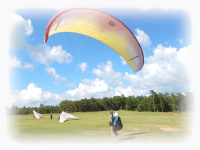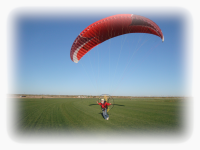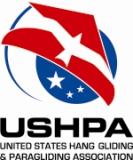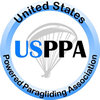FAQs and TIPS
- New students should study the content preceded by an asterisk "*"
Access for ultralights – see "Airport access for ultralights" below
ACCIDENTS – How to avoid them? See "Why stay out of the air today?" and "Safe flying guide" below
*Accidents from high risk activity – Experienced PG instructor Jerome Daoust sums it up as well as anyone. Those of us who have been flying for many years see the carelessness and foolishness of pilots who become injured and worse. What are the causes?
*Accident in Colombia 22 JAN 2019 – Like virtually all accidents, this one was due to pilot error. It was a cascading event that nearly proved fatal. What are the lessons learned? Unnecessary pilot distraction while he was assembling his gear was the cause. Could it happen to any of us? Yes. And it is why we have to be so careful. Master and practice your routine for setting up to fly. Do not change anything, no matter how trivial. Do not talk to people while setting up. Errors here can kill. Do an internet search on "sterile cockpit" and learn what it means. Launch is an ultralight's most dangerous time and that is when a sterile cockpit is most important.
Accident database from the NTSB (all aircraft)
Accidental collision of an airplane with a powered paraglider which was fatal for both pilots
*Joe Parr's famous accident and recovery in Valle de Bravo 2005
Aeronautical abbreviations – What does CTAF mean? If you fly near an airport, you had better know!
Aeronautical charts of the USA – your local airport will have printed copies of the chart for your region, if needed. Symbol meanings and abbreviated Explanations on the charts. The symbol guide is thorough and has more information than is on the charts. Optional: If you PPG, keep these links handy on your mobile phone. If you are stopped for some reason by law enforcement it may help if you demonstrate that you are a responsible pilot.
Aeronautical chart legend (extended version) – detailed explanations of the symbols on aeronautical charts e.g., SkyVector
Aeronautical Knowledge, Pilot's Handbook of
AIR DEFENSE IDENTIFICATION ZONE (ADIZ) - The area of airspace over land or water, extending upward from the surface, within which the ready identification, the location, and the control of aircraft are required in the interest of national security.
AirNav – Guide to airports around the world. Helpful if you want to use a private airport and need to contact someone.
Airplane Flying Handbook – From the FAA. Ultralight pilots should study the relevant sections.
Airport access for ultralights – Need access to a public airport? What are our responsibilities? What does the FAA have to say?
Airport signs and markings – If you wish to operate from an airport, it is helpful to know what all the signs and markings mean. This short guide from the FAA for vehicle operations at an airport is just what you need!
Airport traffic patterns – If a pilot operates an ultralight near or at an airport (non-towered), it is a good idea to know what to expect. Generally, ultralights stay out of the way i.e. if the airport has a left pattern, ultralights will operate to the right. In any case, always visit the airport manager.
*Airspace examples – Examples with explanations of a complex airspace that we might wish to fly in.
Airspace explained – Gives a general explanation of the different sorts of airspace we fly in. Mostly for GA pilots but a good site to review for all.
Airspace "E" explained – This is an easy to understand article on "E" airspace, the type where we spend a lot of time.
Airspace on Sectional Charts - another easy to understand primer on how to read sectional charts by G. White
Angle of attack (AOA), flight path angle, and pitch angle – What is the difference between these three? From Boeing
Ameri-Camp RV Owners Manual – This is a hard to find copy of the original manual for this fine RV. We use one to run around the U.S. and stay in when we fly.
Border operations – see "International border operations" below
*Brake usage – Most pilots fly with way too much brake. Here is what can happen and how to use the brakes correctly.
Buzzing by powered paraglider pilots – see "FAR 103 rule violations" below
Catheter – in flight urinal, for men
poor man's Centrifuge – irritated from tubes of anything having air pockets? Here is the answer to whatever it is that keeps coming out after you squeeze the tube.
Certification of paragliding equipment – see "Equipment certification" below
Clipping in – see "Connecting to the glider" below
Cloud street – pilots can fly along these "streets" of lift
Cold weather flying – This section is mostly about clothing. There are different hazards when there is snow and launching can only be mastered by doing it. Launching in snow = you can't see the terrain you are moving into. Think about it. Suffice it to say, it is ONLY for advanced intermediate pilots. PPG flying in snow is the most difficult launching a pilot will ever do.
Comfortable complacency – see "Safe flying guide" below
Cravats – Having a cravat (a fold in the wing) or a friction knot in the lines can be relatively harmless or extremely dangerous. Pilots must be able to
assess the situation quickly and not panic. Here is an example of a pilot (Tom Bird) launching with a cravat, assessing the severity, and taking
care of it. You will be likely to survive paragliding if you have a cool head.
Cross country paragliding – Notes by Had Robinson on Jocky Sanderson's "Speed to Fly" video
Cross country tips – from Tiki Mashey's Cowboy Up Hangliding XC clinic June 2023
Cross country soaring – This is an outstanding PowerPoint presentation on weather analysis for cross country soaring by Brian Resor of the Albuquerque Soaring Club, Moriarty, New Mexico
Cross country tips from Cross Country Magazine
Dennis Pagen on the weather
Dixon White's Notes – notes on weather, practicing, pilot attitude, flying protocol, speed systems, towing, and more. From Eagle Paragliding.
Drowning – The #1 cause of death among powered paragliding pilots.
EAA – Here is a short summary of what an ultralight is and its legal status. Joining the EAA and registering both yourself and your aircraft is a good start if you fly in an area that is generally hostile to ultralights.
Equipment certification – Paragliding equipment testing and certification to EN standards. Why is a glider rated "EN B", for example? Here is where you can study all of the tests of equipment and what it means. Passive safety is very important when things start to go wrong....
Equipment, PG paragliding – typical
Equipment, PPG powered paragliding – typical
EN testing and certification – see "Equipment certification" above
Ericsson military surplus field telephone – How to setup up these amazingly tough field telephones. At flying events in countries where handheld radios cannot be used for one reason or another, these field telephones are the #1 choice.
Extreme Sports – We are not crazy for doing these things. See the essay at the bottom of this page, "Will Gadd on dangerous sports".
**FAR 103 – The official FAA regulations for ultralights. It is important to read and understand this (4) page document. Ultralights are not subject to *any* other FAA regulations (here is the official answer from the FAA concerning this). An aviation attorney discusses what is a "congested area". To sum up, if someone is on the ground by his house and he does not like the noise or invasion of privacy presented by an ultralight, it is a congested area as far as the FAA is concerned. Section 91.119 (FAA Guide to Low-flying Aircraft) also give some clarity over how the FAA defines "congested". The Jeff Goin has a helpful page on what "congested" means. Basically, do NOT FLY within the limits of any municipality. If you do, you better be really high or clearly in an open area where there are no buildings or people. Even then, the authorities can go after the pilot.
FAR 103 elements – FAA discussion of the elements of an ultralight in order to define what it is and how it fits in to the national air space
FAR 103 notes – Cpt. Jack Brown explains the real meaning behind FAA regulations for PG pilots per "see and avoid".
FAR 103 rule violations – if you observe an ultralight operating in an irresponsible or unsafe manner, here is what to do.
Flapping your glider – under the right conditions it is useful
Flying low – Flying low to the ground gives a false sense of security. Here is why...
Flying safely – see "Safe flying guide" below
Flying south of the U.S. Border & returning – If you do this, here are the rules
Friction knot – an innocent looking tangle in the glider lines can KILL.
Gaggle flying – ONLY intermediate pilots who have mastered circling should thermal with others unless you want this to happen.
General Training Information – Basic info about paragliding training
GPS basic navigation settings – this is helpful for both general navigation with any GPS enabled device or for competition including setting routes, proximity cylinders, waypoints, etc. Be sure to have your GPS manual handy for reference.
GPS Garmin manuals Garmin 64st Garmin 60CSx
GPS Garmin Navigation-Professional has comprehensive downloads and profiles (for the Garmin line)
GPS Setup – Garmin 64st basic setup guide from "Navigation-Professional" of Germany, other models and brands similar
He/She – Bad English from the Marxists and their allies who want to spread disorder, divide, and upset people in the name of "progress". Somebody has to stand up to this crowd that weaponizes every thing they come in contact with while using crowbar tactics and deceit.
High Wind Launches – What you need to know and how to safely do them.
Hunting, harassing or chasing birds, fish, or other animals from an aeronautical vehicle is a Federal crime. This includes buzzing horses or cattle. This site gives more details on the law. The penalties include imprisonment and hefty fines. However, we can legally hunt depredating animals (feral hogs, for example) from the air. Here are the details for Oklahoma. All other states have similar statutes. Note that the USDA is also involved in the permitting process. These dummies did not obey the regs and they wish they had. It was pricey losing their helicopter.....
HyperCut – see "Towing safety" below
Illegal operations by ultralight pilots – see "FAR 103 rule violations" above
inReach satellite communicator – See the "Satellite communications for pilots" page below.
International border operations – if you fly near the Mexican border, here is what you should do. What happens if you land in Mexico?
IPPI card – see "Travel" below
Jetstream – an animation of the Jet moving around the globe. Is it any wonder that it drives the weather?
John Gallagher – words of flying wisdom from an instructor and one of our most experienced paragliding pilots
Justrite carbide lamps – "when all other light have gone out, these will provide a light when it is most needed...."
*Joe Parr's famous accident and recovery in Valle de Bravo 2005
Jump-starters for your truck or paramotor – the batteries eventually need replacement. Now what? Here is the solution that saves $$$
Kill system, alternate – The inability to shut down a runaway engine could be exceedingly dangerous, especially with bigger engines. This alternate system routes a cord from the spark plug boot to some accessible place.
*Kiting practice – Kiting skills are essential for safely flying a paraglider. And practice is FUN! If you cannot kite at launch, you should not fly from launch.
Landing a paraglider safely and comfortably – This is a PPG demonstration of a landing. PG is virtually the same.
Landowner's guide to allowing ultralight access – How does a municipal government, for example, regulate ultralight access to a public area? Here are some guidelines.
Launching and flying in strong conditions – What can go wrong when you launch in strong air.
*Lockout – What it is and how to avoid it while being towed.
Low on fuel – What should a PPG pilot do to maximize time in the air so that he can return home?
Mental overload flying – see "Task saturation" below"
Mexico Travel – see "Traveling to Mexico" below
Motion induced blindness – Why a pilot needs to keep his eyes and head moving at all times. Object fixation can prevent a pilot from seeing nearby objects.
National Weather Service broadcast frequencies – You must have a radio that will receive these broadcasts e.g. a handheld FM transceiver like the YAESU FT-60R (see "Radio setup" below.)
NOTAMS – How to file a Notice to Airmen
Nuisance pilots – see "FAR 103 rule violations" above
*Parachute landing fall (PLF) technique – PLF can save you from serious injury. Courtesy of Southern Skies
Paraglider physics – How it works (Courtesy of www.TowMeUp.com)
Paraglider repair and inspection – we have used AirToyz for many years and highly recommend them.
Perufly flight suits – The first thing to fail on these suits is the slider for the zippers. We have a limited supply of the Rey sliders. Please contact us.
Pilot's Handbook of Aeronautical Knowledge – Provides basic knowledge for the student pilot learning to fly. From the FAA for general aviation pilots
Pilot training guide – from the British Hang Gliding and Paragliding Association
Powered equipment failure – paramotors can quit running at the most inconvenient time.
Powered Parachute Flying Handbook – PPC has many similar characteristics to PPG. This handbook has valuable information for all slow moving aircraft. From the FAA
*Pre-Flight check – Are you safely ready to go? Skilled pilots have had serious accidents because they did not complete their pre-flight.
Pre-flight check from USHPA – This is much more inclusive preflight and is more general in nature. It is worth reading this from time to time.
Problems with powered paragliding pilots – see "FAR 103 rule violations" above
Radio info & setup – Helpful info on (2) meter radios used by ultralight pilots
Radio manuals for some common 2m and air-band radios
Reflex gliders – see "Speed – on a paraglider" below
Requirements – You should have meet these minimal physical and mental requirements to help fly safely. If you train with us, they are required.
Rule violations – see "FAR 103 rule violations" above
Reserves – All about them including how and when to deploy. A reserve is not a second chance – it is your last. Courtesy of various sources.
Reserve re-packer – We highly recommend Mark Windsheimer 1372 Sinton Road Evergreen, CO 80439 airtimeHG@aol.com (303) 674-2451
*Safe flying guide – START HERE Notes on how to avoid accidents. See also Why stay out of the air today?
*Safe flying from Ozone – Ozone wants to be sure you are around a long time so you can buy their paragliders. It's a "win-win" for them and us.... Both Ozone and Southwest Airsports hit nearly all of the same points.
*Safety notice from USHPA – A valuable essay on how pilots can avoid getting killed. It is NOT rocket science....
Satellite communications for pilots – SPOT and inReach info & setup for ultralight pilots
Setup for paragliding and powered paragliding – see "Equipment" above
SharkNose technology – from Ozone, what it is and why we are dealers for Ozone gliders
SIV clinics – These are very helpful. However, you can not only learn a lot but also get killed, hurt, or terrified by them.
Six lessons being a military pilot taught me for life by Carl Forsling – ”Don’t drop the airplane to fly the microphone.”
Smoke deployment – There are so many ways a pilot can set himself on fire in the air if he is not careful....
Spacial disorientation – what killed John F. Kennedy Jr.
Speed – on a paraglider How are they designed to go fast? How does a reflex glider work? (from www.free.aero)
Speed bar installation – A helpful YouTube from Gin on how to do it, courtesy of Super Fly. Note: loose speed bars can tangle with the reserve.
Speed bar systems on paramotors – Dangerous during a forward inflation because a speedbar line can catch on a sidebar and cause a frontal
Speed to fly by Jeff Greenbaum – A simple explanation of how to go farther in a headwind or a downwind
Speedometer repair – the Toyota Tacoma is the vehicle of choice for HG and PG pilots. The older models, however, that have mechanical speedometers have problems, especially noise and wild variations of the indicator. Here is the fix for this. Other older vehicles with mechanical speedometers have the same problem.
Spiral dives – learning how to get out of the air QUICKLY is an important skill that we teach P2 students how to do *safely*. When things go really wrong, pilots will likely enter a spiral dive – another reason to get comfortable with this maneuver.
SPOT – for setup and information see "Satellite communications for pilots" below.
*Stabilizing your glider while doing a reverse inflation at launch
Streamer preparation & deployment – How to prepare, deploy, and tow a streamer with a paramotor
Strobe light setup – The purpose of a strobe light is for you to be visible in the twilight periods of the day.
Tandem operations in the United States – Strictly prohibited unless the pilot in commands meets the specific requirements of USHPA or USPPA.
Tangled glider lines – How to quickly untangle your lines when it is a complete mess.
Task saturation – here is an example of it and why this sport is not for everyone. It is easy to release from tow but not for this new pilot.
Terminal Aerodrome Forecast (TAF) – forecast of expected meterological conditions at airports in North America
How to read the TAF forecasts – from Gleim.com
Thermalling – see "Cross Country Paragliding" above
Throttle placement in the hand while launching a paramotor.
Tight turns just before landing – or missing a bush and breaking your back...
Towing – A complete manual from the Hang Gliding Paragliding Association of Canada
Towing – why we use towing at Southwest Airsports in order to train pilots. It is all about safety.
Towing high – Tips on the high tow (AGL > 2,000')
Towing safety – Southwest Airsports has developed a radio controlled device call the HyperCut which can instantly end a tow by disconnecting the pilot from the towline and the drogue parachute.
Training Part I and Part II by Bill Fortney – Do you make every flight a training flight? This is primarily for LSA but the principles are the same for PG and PPG.
Training with Russell Ogden – He discusses everything paragliding. Mastering wingovers with only weight shift is one of the best things to do.
Travel – Your USHPA rating is good in countries that require all pilots to be rated but you must have an IPPI card. Here's how to get it.
Traveling to Mexico – Helpful tips and advice for pilots (or other sport tourists) entering Mexico in a vehicle with gear. On the other hand, if you want trouble while traveling in Mexico and most other Latin countries, check this out.
Tree landings – tips from Topher Mira of the New England Hang Gliding & Paragliding Association
Trespassing by pilots – see "FAR 103 rule violations" above
Ultralight definition – see "EAA" above
*USHPA Basic Safety Requirements – This short document gives a summary of how to fly safely.
USHPA rating system for pilots – Go here for a complete reference of the USHPA rating system for pilots (P1 - P5)
*Videos of paragliders launching, flying, and landing. It includes some accidents that should be studied.
Violations by pilots – see "FAR 103 rule violations" above
Weather for Aircrews – Basic weather info for non-professionals 1997 version (Vol 1) published by the U.S. Air Force. Vol 2 is more military in nature.
*Why stay out of the air today?
Will Gadd on dangerous sports – Should we grieve for fellow pilots when they perish doing what they love?
XC flying – see "Cross Country Paragliding" above
![]()




